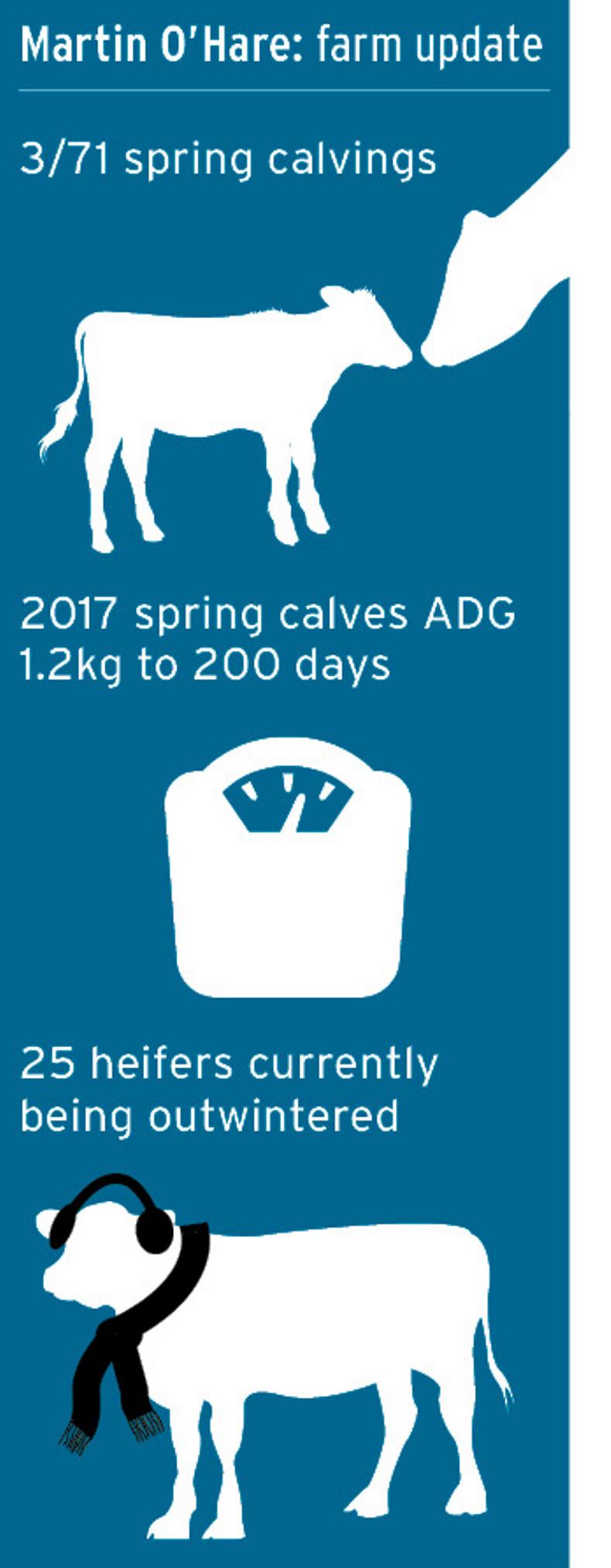In Knockbridge, Co Louth, Martin O’Hare has three 2018 calves on the ground already. It’s a busy time for the 33-year-old – his wife Eilish gave birth to their first child just before Christmas and the pair are building a house adjacent to the farmyard.

In all, there are 71 calves due in 11 weeks this spring. Late March should see Martin’s last calf drop and his 18 heifer calvings are front-loaded. Another 23 animals will calve in the autumn, as Martin looks to build his suckler herd towards 100.
“One hundred cows, finishing all progeny is where I’d like to get to. There’s 60ha on the farm in all but some is under tillage (18ha in 2016/2017). I see more of this going into grass in future. I’m open to taking in stores for finishing too – we bought in five beef bulls to finish with the 2015 autumn-born bulls last year,” Martin told me. 
He uses a combination of stock bulls and AI for breeding. His 2018 first-calvers are carrying ZAG, FTY (Limousin), SA2153 (Saler) and RGZ (Angus) – all sires with calving difficulty figures sub-5%.
AI bulls
In terms of his cows, AI bulls of note are the relatively new Limousins LM2116 and LM2206 and the much-lauded Simmental SI4083. Martin keeps a young (born November 2014) stock bull by the infamous CF52, who is currently running indoors with Martin’s autumn herd in a “mop-up” capacity.
Twenty-one of 23 animals were served with AI before the bull went in in mid-December. He has five stars (€148) on the terminal index and from birth to 9.6 months of age, his spring 2017-born progeny achieved 1.21kg of daily weight gain.
Shed space is a limiting factor for Martin’s expansion plans. An outdoor slatted tank at the entrance to the farm’s old dairy was nominated by the BETTER team and Martin’s own adviser Hugh Rooney as a potential location for a cheap shed development. However, this was put on the back burner in 2017, as Martin’s own home build proved a big drain on both time and cash.
Instead, Martin capitalised on 22 acres of GLAS crops as a means for outwintering 25 yearling heifers. The catch crop contains cultivars such as leafy turnip and fodder rape.
“We went in there in December and I’m giving the heifers a fresh strip every day. They’re getting 1.5kg of meal per head daily and eating two bales of silage a week between them. It’s a dry part of an outfarm beside my brother’s land and the sod is holding up very well,” Martin said.
Martin’s heifers are framing up excellently in their outdoor environment and should see a good thrive when they move on to grass in the coming months. They were given iodine and general-purpose mineral boluses before moving on to the catch crop. The field will go into spring barley in 2018.
The plan with these heifers is that they’ll move to Martin’s silage ground towards the end of February, along with some of their housed counterparts.
There’s currently a cover of 650kg DM/ha on his silage ground and Martin will look to completely graze the area before the first week in April, with a view to a main first cut of silage in late May. Given the fact that Martin is carrying autumn-calving cows and finishing both his own and bought-in cattle, silage quality is vitally important. Sub-standard quality must be balanced with concentrates and this practice would eat into Martin’s bottom line.
Silage
Back in the yard, Martin’s dry cows are currently receiving 66% DMD grass silage and 120g of a pre-calver mineral. They are being drafted into his calving house as they spring up/their date approaches. Here, a 3G camera with a live feed to Martin’s smartphone is fitted.
While his calving date means that young calves spend more time than desired indoors in an environment with a potentially high disease burden, Martin’s sheds are equipped with creep areas and his tillage enterprise means that he has ample straw for bedding.
The dry nature of the home farm and the fact that he was strict about closing up his early-spring paddocks first, last back end, should allow him to get cow/calf pairs out permanently when the first significant dry spell comes.






 This is a subscriber-only article
This is a subscriber-only article



















SHARING OPTIONS: